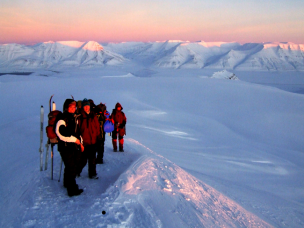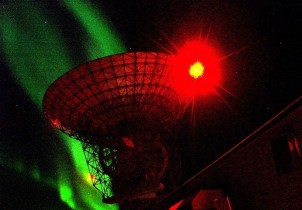Study in the High Arctic

Svalbard: Land of Polar Bears and Aurorae
Svalbard is one of the most exotic locations on Earth. It is an archipelago of islands spanning latitudes from about 74N to 81N, far inside the arctic circle. It is one of the few unspoilt wilderness areas left - much of the islands are covered in glaciers and are home to wildlife including polar bears, reindeer, walruses, seals and arctic foxes.
 Svalbard is the ideal place to study atmospheric, ionospheric and space physics because at high latitudes dramatic phenomena occur which are inaccessible elsewhere, such as the stratospheric polar-night vortex, ozone depletion, and the connection of the planet’s magnetic field to interplanetary space via the open field lines found at polar latitudes.
Svalbard is the ideal place to study atmospheric, ionospheric and space physics because at high latitudes dramatic phenomena occur which are inaccessible elsewhere, such as the stratospheric polar-night vortex, ozone depletion, and the connection of the planet’s magnetic field to interplanetary space via the open field lines found at polar latitudes.
 Students taking MPhys Physics with Planetary and Space Physics have the unparalleled opportunity of spending the second semester of their final year (January-May) studying at UNIS (University Centre on Svalbard) an international university in the town of Longyearbyen on Svalbard. Students from across Europe meet to study advanced courses in polar science (all teaching is in the common language of English and there are no additional tuition fees). Longyearbyen is a lively town with restaurants, an art gallery and museum, a sports hall and swimming pool, pubs and a cinema.
Students taking MPhys Physics with Planetary and Space Physics have the unparalleled opportunity of spending the second semester of their final year (January-May) studying at UNIS (University Centre on Svalbard) an international university in the town of Longyearbyen on Svalbard. Students from across Europe meet to study advanced courses in polar science (all teaching is in the common language of English and there are no additional tuition fees). Longyearbyen is a lively town with restaurants, an art gallery and museum, a sports hall and swimming pool, pubs and a cinema.
Students live in purpose-built modern accommodation and are taught by University staff from Norway of international standing . The subjects studied are:
- Radar Diagnostics of Space Plasmas (Space Physics)
- The Upper Polar Atmosphere (Ionospheric Physics)
For the latest information about the EISCAT research projects at Svalbard visit their website here and here.
